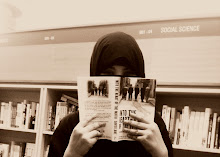Foreign Policy published their
May / June 2012 edition recently and the main theme of the issue was matters related to women. More specifically women rights', female oppression in the MENA region and so on.
However, the cover picture of the issue is a bit controversial and hit a personal nerve. It is a picture of a naked woman with a painted on black veil (niqab) with the caption,
"Why do they hate us?" which is also the title of the article written by Mona El Tahawy who talks about female oppression in the MENA region.
(The article in itself is something that I have a bit of trouble with. I don't believe in a Men Vs. Women approach when it comes to solving gender problems or that Islamists are the root of all evil, that is Monas personal views talking, but that is for another blog post)
This is what was on the cover issue of Foreign Policy's edition for May / June 2012:
The photograph reappears in Mona El Tahawys article, "Why do they hate us?" but in a different pose. The woman is portrayed in a more submissive and subjugated manner.
My problem with the above pictures are the implications. I have been wearing the Niqab / Burqa / face-veil for nearly 6 years now. I wear it by choice and in the past few years I've seen a lot of portrayal of the face-veil in the media. Sadly, most of it is negative, misinterpreted or caters to western orientalist fantasies of Muslim women being oppressed and needing to be saved. All the attention there is in the media on the niqab, a piece of cloth that is worn by a minority of women around the world, either presents them as being oppressed or not knowing their own minds.
We never see any positive news on women who wear the veil. Why not feature those women who wear the face-veil and yet are doctors, engineers, writers or simply house-wives but lead normal and productive lives? Why not feature the Muslim women fighting to wear the face-veil in countries like France or those like Manal Al Sharif from Saudi Arabia who stood up for women being allowed to drive?
They could have chosen so many different pictures to portray oppressed women, why a niqab / burqa wearing woman?
Foreign Policy follows the media tide in its sweeping generalisations on the face-veil and caters to the misguided view that all niqab / burqa wearing women are forced, oppressed, uneducated and need to be saved. Why else would this woman appear in a picture looking subjugated right next to an article that talks about female oppression? The implications are obvious.
Don't get me wrong, I'm not denying that there are issues concerning women and women empowerment in the world, especially in the Arab / Muslim world. I wholly support the empowerment of women but it needs to be understood that freedom does not necessarily mean stripping our veils off us. People find it hard to believe, but a good percentage of women do
actually wear the veil, either face or head by choice. I know that I certainly do and I can account for dozens of other women who I personally know who wear the face-veil from different walks of life that do so as well. This needs to be understood and taken into account.
The generalizations here are sweeping: Muslim Women who veil, especially those who don the face-veil = oppressed. The implications are more obvious when the picture appears again in Mona El Tahawys article on female oppression in the MENA region. It's the same cycle used in various media publications when it comes to this side of the world.
Female oppression in the Arab / Muslim world. Check. Woman in Niqab as picture on the side. Check.
Initially I thought Mona had a hand behind it considering her past negative views and comments on the face-veil but she denied it in her tweet.
So technically it is the artist and foreign policy to blame for pandering to western orientalist fantasies, however Mona clearly has an 'agenda' and we see this within the article. Islam is portrayed as the root of all problems facing women in the Middle East.
These days in the media, either Muslim women are portrayed as being exotic and sexy creatures (obvious from the first page with the dolled up eyes, niqab and the little box on the right that says, "The sex issue") or they're portrayed as being oppressed, waiting for the world to save them. Foreign policy does it both ways.
I wish for once we're portrayed as
normal. That when there are articles and publications discussing women issues, especially those in the Arab / Muslim world a veiled woman is not smack drab in the middle of it. Or if she is, let there be some positivity about it. Last but not the least, Mona El Tahawy needs to stop being taken as a spokesperson for Muslim / Arab women just because she is a "Muslim" and Arab-American.


















